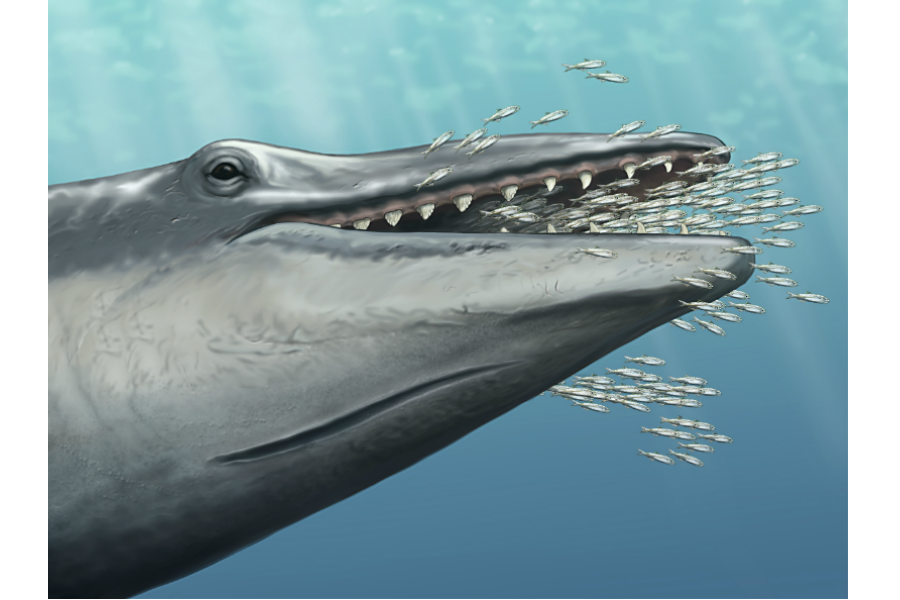How did baleen whale ancestors lose their teeth?
Baleen whales – humpback whales, blue whales, right whales, minke whales, and other whales that use filter feeding – include the largest animals ever known to live on Earth, and yet they dine on tiny organisms like zooplankton, krill, and small fish. To fuel such humongous bodies, the ocean giants scoop entire schools of fish into their mouths, filtering the water and other stuff that ends up in their mouths through bristly keratin structures called baleen.
But their ancestors' mouths didn't always have such an efficient filtering system. Instead, they just had teeth. So what happened in evolution for those prey-grasping teeth to disappear and the baleen filter feeding system to take its place?
There may have been an intermediate stage employing a different mode of feeding: suction, scientists propose in a paper published Wednesday in the journal Memoirs of Museum Victoria. This research could answer key questions to a major evolutionary transition along the lineage that ultimately yielded the biggest animals in the world.
The evidence comes from a 25-million-year-old whale fossil nicknamed Alfred, who lived during a time when scientists think baleen whales were evolving from more shark-like raptorial feeding to filter feeding. And Alfred had teeth.
It wasn't the presence of teeth that tantalized researchers, it was what was on the teeth. Fine scratches on the inside of the teeth looked familiar to some of the scientists, says study co-author Erich Fitzgerald, curator of vertebrate paleontology at Australia's Museums Victoria.
"That kind of wear is only seen in a couple of living marine mammal species," Dr. Fitzgerald says in a phone interview with The Christian Science Monitor. "Those are species which use rapid retraction, backwards movement of the tongue and throat, to generate suction." The behavior is much like sucking a milkshake through a straw.
Adult walruses use this same method to dislodge clams and other shellfish from the seabed, but the suction also picks up rough sediment, Fitzgerald explains. And over time, this repeated abrasion leaves scratches much like those seen on Alfred's teeth.
Dental wear is a good way for paleontologists to determine an animal's behavior, Brian Beatty, an evolutionary biologist and anatomist at the New York Institute of Technology at Old Westbury who was not part of the research team, says. "Dental wear is a direct measure of the physical interaction of an animal with its environment," he tells the Monitor. It's a trace fossil, like dinosaur footprints, left behind by a behavior.
This isn't the first model that has been proposed to describe the transition from teeth to baleen in Mysticeti, the scientific name for baleen whales. Other fossil evidence has suggested that the whales developed baleen while they still had teeth, instead using both biting and filter feeding until the teeth slowly disappeared over generations.
But Fitzgerald says Alfred couldn't have had any baleen because the structures would have protected the ancient whale's teeth from the abrasive sediment and other scratchy schmutz.
"I think this is going to be a seminal paper," Christopher Marshall, a comparative physiology and ecomorphology researcher at Texas A&M University at Galveston who was not part of the research team, tells the Monitor. "This provides a very plausible mechanism to get from biting to filter feeding."
The idea that suction played an important role in the transition makes sense to Dr. Marshall, as his own research on seals also suggests suction precedes or is a part of the evolution of filter feeding behaviors.
But Annalisa Berta, an evolutionary biologist at San Diego State University whose own research lab has also focused on this evolutionary transition, isn't convinced baleen and teeth didn't overlap. Although she agrees that suction probably played an important role in this transition, Dr. Berta says, "This is a lot to base on just one specimen."
The presence of baleen in these transitional fossils has been inferred by researchers looking at small holes and channels on the roof of the mouth that may be signs of nerves and blood vessels connected to baleen structures, and not from actual preserved baleen itself. So, Dr. Beatty explains, they could be structures for a blood supply supporting other tissues, like gums, in the ancient whales instead.
Or, Berta suggests, maybe baleen and the structures around it didn't always look the way it does today. Besides, she points out, the part of Alfred's palate that would display such holes and channels is missing in the fossil.
"The challenge is that it's hard to test something as complex as feeding in the fossil record when we don't have direct evidence of the thing we need, which is baleen," Nicholas Pyenson, curator of fossil marine mammals at the Smithsonian National Museum of Natural History in Washington, D.C., who was not involved in the study, tells the Monitor.
But he agrees that it is "not outside the boundaries of our expectations" that suction played an important role in the transition. Why? Because, Dr. Pyenson says, "suction feeding is one of those basic things that all mammals do because they have to nurse from mothers."
Alfred was named by Fitzgerald's colleagues in the spirit of alliteration, he says, as he is an aetiocetid, or a member of the family of extinct toothed baleen whales that lived in the Oligocene (from about 34 million to 23 million years ago).
Alfred was a moderately sized whale, measuring somewhere between 9 and 12 feet long, Fitzgerald says. The animal would have been about the size of a bottlenose dolphin. But its relatives that live today and rely on filter feeding to supply their bodies with nutrients are much larger.
The most massive baleen whale is the blue whale, which can grow up to nearly 100 feet long. And that makes it the largest animal known ever to live on Earth or, as Fitzgerald says, "pending discovery of life elsewhere, technically the largest animals in the universe."







